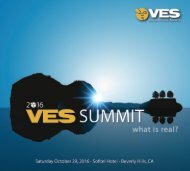Create successful ePaper yourself
Turn your PDF publications into a flip-book with our unique Google optimized e-Paper software.
<strong>VFX</strong> VAULT<br />
THE MINIATURE MODELS<br />
OF BLADE RUNNER<br />
By IAN FAILES<br />
TOP: Christopher S. Ross checks the scale convergence of the Hades<br />
Landscape. The artist drew the black silhouettes, in progressively reduced<br />
scales, over Virgil Mirano’s reference photography of the El Segundo<br />
refinery. They were arranged on 12” x 24” artboard panels from which<br />
lithographic films were made. The acid-etching supplier used the films<br />
to print stencil masks onto 12” x 24” brass sheet stock for etching the<br />
silhouettes (similar to the process used to make printed circuit boards).<br />
BOTTOM: The Hades Landscape model on the smoke stage set up on<br />
tables with under-lighting. Fans helped control the heat generated.<br />
In 1982, Ridley Scott’s Blade Runner set a distinctive tone for<br />
the look and feel of many sci-fi future film noirs to come, taking<br />
advantage of stylized production design, art direction and visual<br />
effects work.<br />
Supervisors Douglas Trumbull, VES, Richard Yuricich and David<br />
Dryer – via Entertainment Effects Group – oversaw Blade Runner’s<br />
Oscar®-nominated visual effects; work that was completed at a<br />
time when practical effects, miniatures, optical compositing and<br />
real film (in this case, 65mm film) were the norm.<br />
On the eve of the release of Denis Villeneuve’s Blade Runner<br />
2049 sequel, <strong>VFX</strong> <strong>Voice</strong> revisits the miniatures of the original<br />
film with chief model maker Mark Stetson, VES. He and a crew<br />
of distinguished artists helped to craft many of the film’s iconic<br />
settings and vehicles, including the opening Hades landscape,<br />
Tyrell Corporation pyramids, the Spinner and other flying vehicles,<br />
the advertising blimp and the Los Angeles city landscape of 2019.<br />
AN INDUSTRIAL BEGINNING<br />
Blade Runner begins with a slow push-in over a heavily industrialized<br />
section of Los Angeles. Many were surprised when it became<br />
apparent that the endless refinery imagery – known as the Hades<br />
landscape – was largely achieved with rows of acid-etched brass<br />
silhouette cut-outs in a forced perspective layout.<br />
“The original thought,” says Stetson, “was that Hades would<br />
be shot in a smoke room, it would all be backlit, and we would<br />
build it on a transparent tabletop so we could angle the lights with<br />
these rows of silhouettes. It didn’t really work out that well in that<br />
respect – there wasn’t enough lighting control or depth in the<br />
fine-scale miniature to separate the layers. So we decided to add a<br />
ground plane of cast-detailed parts to the foreground.”<br />
The ground plane structures were painted quite roughly to make<br />
the buildings look ‘aged and crappy’ – instant coffee was even<br />
used for that effect. Then, after making an evening flight into Los<br />
Angeles, Stetson was inspired to replicate in the Hades landscape<br />
the look of thousands of city lights.<br />
A myriad of fiber optic strands – seven miles worth – was added<br />
underneath the tables holding the silhouettes and other model<br />
pieces. The lights included a mix of different bulbs, too, all filmed<br />
in different passes, as were the gas flares captured ‘in-model’ with<br />
specially placed projection screens and a synchronized 35mm<br />
film projector.<br />
PYRAMIDS OF THE FUTURE<br />
The Tyrell Corporation, responsible for genetically engineered<br />
replicants in the future-verse of Blade Runner, has its headquarters<br />
in a pair of enormous pyramid-shaped buildings constructed<br />
by Stetson’s team as miniatures. Their trademark look involved<br />
intricate side panels made to look as if consisting of thousands of<br />
lit windows.<br />
The core pyramid structure was built essentially as a clear plastic<br />
shell. Flat panel patterns were accurately cut to make up the basic<br />
pyramid shape. The patterns’ surfaces were intricately detailed<br />
with plastic strip stock. “We laid down one quarter-inch plastic<br />
angle stock on its edges to create a stair-step surface,” says Stetson.<br />
98 • <strong>VFX</strong>VOICE.COM FALL <strong>2017</strong>




